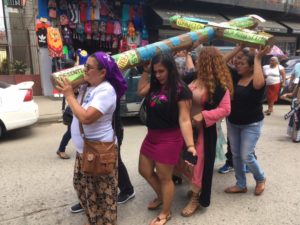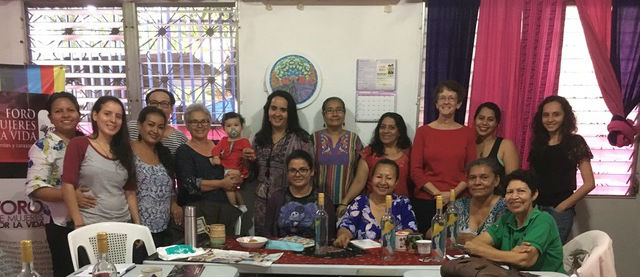Praying the “stations of the cross” is a longstanding Lenten tradition all over the Christian world, during which believers are reminded of the last moments Jesus lived through as he carried his own cross to the crucifixion. Throughout Latin America, the Way of the Cross, or Via Crucis, is often an elaborate procession, during which a life-sized cross – usually made intentionally heavy – is carried to each inflection point of prayer.
 The Via Crucis we followed last month in San Pedro Sula, Honduras, was different. It demonstrated vividly the power and peril faced by those whose deepest faith compels them to stand up against oppression. The cross they carried was covered with words — poverty, violence, hatred, murders, torture, imprisonment – naming explicitly the weight the people carry, under the repressive presidency of Juan Orlando Hernandez. Those in the procession also carried 34 smaller crosses, each one bearing the name of a person who had been shot and killed by security forces in the past two months, since the fraudulent election that ensures Hernandez will continue in power.
The Via Crucis we followed last month in San Pedro Sula, Honduras, was different. It demonstrated vividly the power and peril faced by those whose deepest faith compels them to stand up against oppression. The cross they carried was covered with words — poverty, violence, hatred, murders, torture, imprisonment – naming explicitly the weight the people carry, under the repressive presidency of Juan Orlando Hernandez. Those in the procession also carried 34 smaller crosses, each one bearing the name of a person who had been shot and killed by security forces in the past two months, since the fraudulent election that ensures Hernandez will continue in power.
I was in Honduras as one of 50 faith leaders who responded to a call for accompaniment, issued by religious and human rights leaders whose lives are in increased jeopardy as they continue to voice their indignation and opposition. Our Via Crucis was allowed to proceed without interference. But later that day, and throughout our week in Honduras, we witnessed peaceful protests violently dispersed by members of the police and military.
This violence in all of its forms is the very real and present cross that our Honduran siblings carry every day. It is carried as well by human rights champions in El Salvador and Guatemala, and by the thousands of men, women, and children who are driven from all three countries to the deeply perilous path they follow north. If they make it across the US border, the migrants carry the weight of detention, actual or feared, and the uncertainty that shadows each moment.

In this Lenten season, as I remember the Via Crucis in which I participated in Honduras, I am thinking about what parts of the cross are mine to carry as a citizen of the United States. The teargas, water cannons, and live ammunition I saw used in Honduras are all products of the USA. In a very real sense, the Honduran government itself is a result of the approval and recognition our nation offered in the wake of the 2009 military coup, and offered again this past November in recognizing fraudulent elections. I want to stay awake to these truths. It’s by staying awake that we can find ways to act to shift US policy, and thereby shift the weight of the cross from the shoulders that have carried it for far too long.

